Claude Papesch
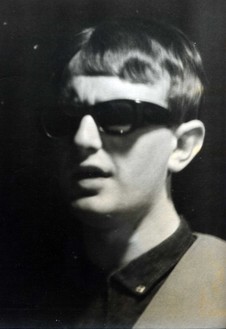
Claude Papesch, circa 1965 - Dave Ross collection
Claude Papesch first came to prominence in 1958 when, at the age of 16, he was asked to put together a backing band for Johnny Devlin, whose career was just peaking. The Devils – including Claude, Peter Bazely (guitar), Keith Graham (bass) and Tony Hopkins (drums) were, in John Dix’s words, “New Zealand’s first truly great rock’n’roll band”. Claude was an outstanding musician, proficient on sax, clarinet and keyboards; his father, Joe Papesch, was a professional organist and music teacher, also totally blind. During the 60s Claude worked extensively in New Zealand and Australia, playing with the likes of Ricky May and Bruno Lawrence, holding down residences at clubs such as Sydney’s Latin Quarter, Auckland’s Mojo’s, The Montmartre and many more. In the early 70s he crossed the Tasman for good, to make his living touring and recording with many people, including a stint with BLERTA in 1974. He eventually settled in New South Wales, where he worked mainly in the jazz field. Battling cancer during the last years of his life, Claude served on the Lithgo City Council and was elected Mayor in 1984. He died aged 45 in February 1987.
Lyall Laurent
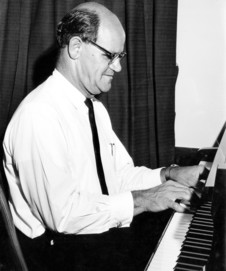
Lyall Laurent on piano. - Mark Laurent Collection
One of Auckland’s best-known and respected jazz pianists, among the cognoscenti Lyall Laurent – my father – was admired for his encyclopaedic chord knowledge and exceptional left hand technique. He started playing at the age of seven, in 1932 he had his first paid job at 15, and he averaged three gigs a week for the next 50-plus years. Lyall played dances, hotels, clubs, restaurants – name a venue, he probably worked there – as well as doing some radio and recording, mainly in the Auckland region. Over the years he was a member of Epi Shalfoon’s band, the Paul Lestre Trio, Merv Thomas’ Dixielanders, and performed in combos led by Jimmy Warren, Dave Forman and Julian Lee, to name a few. Through the 1990s he did a long stint with Tommy Adderley at the London Bar. Lyall was still taking all the work he could get, and enjoying it, right up until his death in January 1999.
Lottie Trevarthen
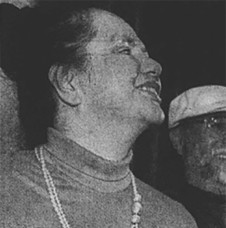
Lottie Trevarthen, aka Lottie Latimer and Lottie Neville
Depending on how long ago your nightclubbing days were, you may remember her as Lottie Lattimer or Lottie Neville. When very young she met the legendary blind advocate Helen Keller, who wanted to meet “a Māori child” while visiting New Zealand. Lottie studied classical piano (no mean feat for someone totally blind) and became interested in jazz through listening to Dave Brubeck. Originally working as an accompanist, she gradually insinuated her considerable vocal ability into the act – the style for which she is now best known. Once she hit the club/pub scene her conquests included most of Auckland’s jazz venues of the 60s and 70s. She was a core member of The Sophisticats with husband Derek Neville, and over the years gig mates included Bruce King, Lou Mercer, Andy Brown, Bruce Morley, Dick de Gray and many others. (Derek and Lottie lived on Wharf Road, Herne Bay – the same street as Crombie Murdoch.) Lottie also put a lot of her energy into working for the welfare of visually impaired women and Māori.
Julian Lee
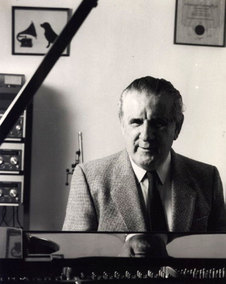
Julian Lee, multi-instrumentalist, arranger, and mentor
One of New Zealand’s premier jazz exports, Julian Lee was born in Dunedin. Like the other blind musicians in this article, he learnt to play piano while attending the Foundation for the Blind’s school in Parnell, Auckland. He soon proved to have an exceptional ear and ability, so it wasn’t surprising that he embarked on a professional music career straight from school. He went to Australia in the 1960s where he met blind American pianist George Shearing, who offered him the possibility of work. Through the later 60s and most of the 70s he moved back and forth between Australia and the United States, performing, arranging and recording with Shearing, Peggy Lee, Gerry Mulligan, Don Burrows and many more. Julian lived primarily in Sydney, but made trips “home” now and then to visit friends (he and Lyall Laurent grew up together and were best mates at school), and to play jazz festivals, etc. Julian died in 2020.
Eddie Low
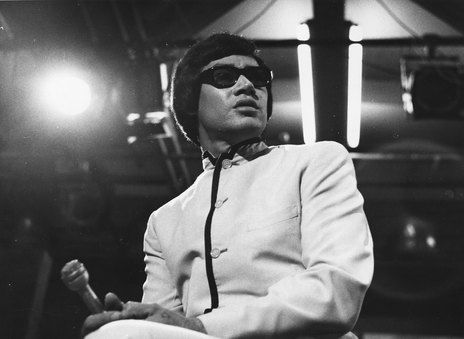
Eddie Low, 1970, on the set of an NZBC show - Robert Joiner, Redmer Yska Collection
Eddie Low was born in Rotorua and modelled himself on Elvis Presley and Roy Orbison. His first band, the Truetones, also included Ken Smith, Trix Willoughby and Ted Toi, with Lynette Brown sharing the vocals. As well as the usual socials, they worked as a backing band for numerous talent contests and did a stint of touring with Lou and Simon in the early 60s. Eddie met John Rowles, and together they travelled to Australia where he met the Quin Tikis and worked with them for nearly 10 years. Eddie performed under his own name from then on, regularly crossing the Tasman (with a brief foray into the US), doing his mix of rock’n’roll and country ballads. As well as being a fine vocalist, Eddie played guitar, keyboards and trumpet, and his numerous albums contain a mixture of covers and self-penned compositions. Latterly, Eddie concentrated on the RSL/RSA circuits. He died in 2024.
Toni Savage
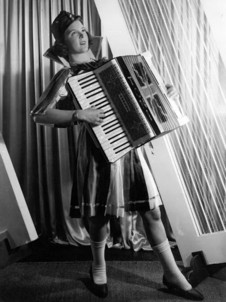
Toni Savage aka Toni Swan. - Auckland Libraries, NZMS 1746 4.3.1
Laura Joan “Toni” Swan (née Savage) began her career singing and dancing, playing accordion and ventriloquism for New Zealand and American troops during the Second World War. She continued entertaining throughout her life. She was equally comfortable performing alone, or with groups, including The Kentucky Korn Kobs, and in later years, her own ensemble, The Toni Savage Troupe. Toni also incorporated her ventriloquism puppets “Wonki Wolf” and “Cookie Bear” into her act. Her archive (link at the end of this paragraph) includes photos and audio – a 78rpm disc from the 1940s, features her playing ‘The Twelfth Street Rag’ on accordion. Due to advancing blindness Toni trained to read Braille and use a white cane, and in 1973 met her first guide dog. Because of the help she received from the Royal New Zealand Foundation of the Blind, she used her later performances to promote the guide dog service and raise funds for the Blind Foundation. Toni recorded an instruction tape on training with her guide dog for the Guide Dog Training Centre titled A Friend for Life. In 2008 she was filmed entertaining at the Variety Artists Club. Toni died in 2011. She left substantial archives, which can be viewed at the Auckland Libraries Heritage site.
Richard Hore
Despite the misleading thumbnail, this clip features Richard Hore performing in the final of Opportunity Knocks, 1975
Richard Hore was born in 1956 and lives in Christchurch. Being totally blind hasn’t stopped him leading a full life as a professional musician. He began playing piano at age eight, encouraged by his mum who was an accomplished pianist. At 14 his parents bought his first electronic organ and it soon took over as his main instrument. Richard’s professional career began at 17 when he gained the residency at the Guardsman Restaurant. He got the gig at the public restaurant at Queen Elizabeth II Park during the 1974 Commonwealth Games, and several notable restaurants residencies followed, both as organ soloist and band keyboardist/vocalist. His work was badly affected by the earthquakes of 2010 and 2011. Richard travelled extensively within and beyond New Zealand, performing on electronic and theatre pipe organs. He’s been a product demonstrator for various organ, keyboard and digital piano brands and has played in several iconic Australian and US organ venues. More recently he’s entertained in retirement homes. Between 1972 and 2012 Richard recorded 11 solo organ albums and two digital piano CDs. He earned a Licentiate Diploma in Popular Organ with the Australian Guild of Music. He is a life member and co-patron of the Christchurch Electronic Organ Society and co-patron of the Manawatu Organ and Keyboard Club. Richard was awarded a Queen’s Service Medal in the 2010 New Year’s Honours List, for services to music in New Zealand. “Music is not what I do but who I am.”
The Radars
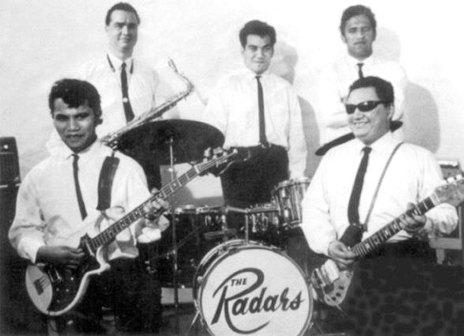
The Radars: Neville Taura (bass), Harvey Baker (saxophone/lead vocals), Feau Halatau (drums/BVs), Andrew Taylor (guitar), Ray Lemon (lead guitar/BVs).
The Radars (there’s a hint in the name) were a band of visually impaired musicians who mainly played around Auckland. The group was started in 1962 by Niuean born drummer Feau Halatau and four fellow students from the Parnell Institute for the Blind. Their first paid gig was a wedding and, according to Feau, they “got a couple of pounds each”. By late 1966 they were the resident band at a dance hall in the Auckland suburb of Ōtāhuhu. They backed singers Ricky May, John Rowles and Rob Guest during their residency at the Picasso club. That residency lasted until 1967. Their first single, ‘Don’t Get Around Much Anymore’ was released on the Zodiac label. They also appeared on NZBC’s TV talent show Have a Shot. By the mid-1970s, when their residency at Ponsonby’s Gluepot came to an end, they had been performing there for seven years. In 1981, the band, along with Quincy Conserve trumpet player Kevin Furey, backed Deane Waretini on ‘The Bridge’, written by George Tait. The song was a No.1 hit in New Zealand. The song, originally released on the Innovation label, and later CBS, was credited to Deane Waretini with “The Rising Stars”. The Radars took to the street to promote their next single, ‘That Lucky Old Sun’, and even got family members to sell it. The track made the New Zealand charts at No.20, and stayed there for six weeks. A few months later their version of ‘The Banana Boat Song’ made it to No.35 for a week. They won the Best Polynesian Album award at the 1983 NZ Music Awards. Also in 1993, along with several other blind musicians, they were featured in an article, ‘Dancing In The Dark’, in the October edition of NZ Musician magazine. In December 2000, marking their fourth decade in the music business, the band played at the Blind Musicians Festival in Parnell. Unfortunately in 2001 they had $10,000 of equipment stolen. They kept going for a few more years, and finally disbanded in 2007, the only two original members being Andrew Taylor and Feau Halatau. Ray Lemon died in July 2008. Other members who passed through The Radars over the years include James Tapini, Selwyn Davies, Billy T James, Dennis Kingston and Alex Constable. Wikipedia has a detailed page on The Radars.
Tai Paul
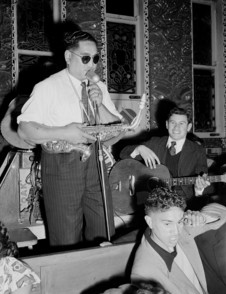
Tai Paul performing at the “Tama”, Rotorua. - NPS AAQT6401-A33689
Tai Paul – “Tai at the Tama” – became Rotorua’s leading act in the 1950s. Taiaroa Paul and his Pohutu Boys would draw locals and tourists to weekly dances at the Tamatekapua Meeting House on the lakefront at Ōhinemutu. Born in Whakatāne, Paul was blinded while fighting at Mersa Matruh in Egypt with the 28th (Māori) Battalion. Already a musician before the war, he learnt to read music at St Dunstan’s Institute for the Blind in Auckland. At this time he recorded an army satire, ‘The Kiwis in Solumn’, broadcast in Digger’s Session on 1ZB. “Forming a dance band was one of my ways of readjusting myself to civilian life,” he said. The Pohutu Boys’ musical director was English pianist Vic Bartholomew; in London he had worked with Billy Cotton and led his own bands. The vocalist/guitarist Angus Douglas had been a Māori All Black, and the group later featured Nick and Ronnie Smith, who became prominent in the Wellington jazz scene. The Pohutu Boys also launched the career of Tai’s son, Rim D. Paul, vocalist with the Quin Tikis in the 1960s; he credited the early Pohutu Boys as a key influence on the showband format of quick changes and themed brackets parodying Hawaiian, Latin and other styles of music. Tai Paul, who also worked as a hospital telephonist for 20 years, was performing with his Pohutu Boys up to two months before his death, aged 57, in 1978. Rim D. Paul talks about his father in this episode of RNZ’s Musical Chairs.
Jann Rutherford
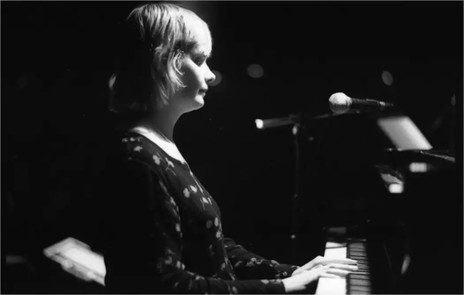
Jann Rutherford - australianjazzrealbook.com
Jazz pianist, composer, teacher and poet, Jann Rutherford was a prominent and unique musical force in New Zealand and Australia. Born in Dunedin in 1964, Jan began learning the piano when three years old after she’d been attracted to the sound of her neighbour playing. In 1977 she was awarded the Sir Denis and Lady Blundell (Governor-General) Homai College Prize for “showing outstanding determination” and continued her classical studies until 1984. The next year she gained a diploma in Executant Music from Wellington Polytechnic, majoring in jazz. She began performing regularly and recorded for radio and TV. Her move to Sydney in 1989 was particularly daring as she was totally blind and travelled alone. Jann attended the Sydney Conservatorium – with Mike Nock and Roger Frampton among her teachers – where she gained a diploma in music teaching.
She also gained the Licentiate Trinity College London. Jann soon made an impact on the Australian jazz scene, working with vocalist Kate Swadling and blind pianist Julian Lee. She won the Whangarata Jazz Festival award in 1993 and was nominated for a Mo Award. Jann led several jazz bands, including a trio with leading bassist Craig Scott and Alan Turnbull on drums, and a lengthy collaboration with saxophonist Paul Cutlan. In 1999 she recorded an outstanding solo piano album, Discovery (Tall Poppies).
This revealed her strengths as a pianist and composer: a beautiful touch and choice of voicings, a flair for releasing tension (both in the music and her listeners), an intuitive understanding of the use of space, an ability to bind her improvisations into coherent statements. She recorded a second album with her band called The Scented Garden, but by this time she had been diagnosed with cancer and the album was released posthumously. Jann died in 2002.
--
Read more: Sight-impaired Musicians in New Zealand